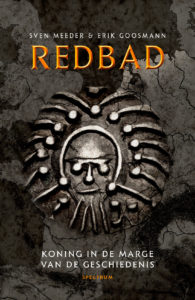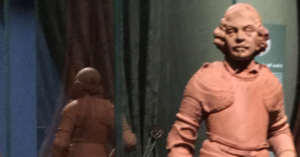[interview met Vox]
Eind juni is de première van de in Nederland geproduceerde film Redbad. Radboud-historicus Sven Meeder schreef een boek over deze Friese koning uit de achtste eeuw – niet te verwarren met de naamgever van de Radboud Universiteit. ‘De film neemt een loopje met de geschiedenis.’
Sven Meeder en zijn collega Erik Goosmann hebben de komst van de film aangegrepen om een boek over Redbad (of Radboud) te schrijven. Niet alleen om de figuur Redbad nog eens uit te lichten, maar ook om uit de doeken te doen hoe historici met problematische historische bronnen werken, hoe het verleden te pas en te onpas wordt ingezet om een eigen politieke of sociale boodschap te verkondigen, en welke krachten hierbij werkzaam zijn. ‘Het gaat ons er niet om een belerend vingertje op te steken tegen de filmmaker en zuur op te merken wat er allemaal niet klopt in de film. Dan is er weer zo’n wetenschapper aan het woord die het beter weet. Wij vinden het interessanter om de verbeelding van het verleden zelf aan de orde te stellen.’
Redbad als stoere strijder
In de Nederlandse film van regisseur Roel Reiné krijgt Redbad de rol toebedeeld van stoere strijder die de Friese gebieden weet te behoeden tegen de verovering en fanatieke kerstening door de Franken, als een verdediger van de eigen cultuur en vrijheid tegen een imperialistische, extremistische vijand uit het zuiden. Dat zwart-wit beeld doet de geschiedenis geweld aan: Redbad bleef weliswaar heidens en vocht meerdere malen tegen de Franken, maar het grootste deel van de tijd handelde hij juist op een heel diplomatieke manier. Meeder: ‘Hij gaf enige ruimte aan de verkondigers van het christelijke geloof en hij wist door te dringen tot de hoogste politieke kringen van Frankenrijk. Decennialang bleek hij uitstekend te functioneren met een voet in elk van de twee werelden. Hij was eerder een politicus en diplomaat dan een koppige strijder.’
Meeder baseert zich op de paar historische bronnen over Redbad die bewaard zijn, vaak decennia later geschreven en doordrenkt met eigentijdse politieke bedoelingen. Wil de echte Redbad opstaan? Een lastige vraag. Meeder: ‘Dat maakt dat ons boek geen platgeslagen geschiedenis over de ‘echte’ wereld in die tijd kan bieden. Dat zou misleidend zijn. We beschrijven hoe historici zo adequaat als mogelijk tot een reconstructie proberen te komen.’ Zo bestaan er bronnen over een paar ontmoetingen tussen Redbad en Willibrord, in die jaren druk met de missie in de lage landen. ‘Redbad had hem gemakkelijk een kopje kleiner kunnen maken, dat heeft-ie niet gedaan. En hij is een alliantie met de Franken aangegaan door zijn dochter uit te huwelijken aan de zoon van de Frankische hofmeier Pippijn. Dat doe je niet als je een fanatieke, heidense barbaar bent.’
Framen van de geschiedenis
 Pippijn is een voorvader van Karel de Grote, in wiens tijd het beeld van Redbad als brute krijger definitief werd gevestigd. Meeder: ‘Karel gebruikte Redbad om de strijd van zijn familie nog glorieuzer te presenteren. Door hem extra bruut en extra heidens af te schilderen, probeerde Karel de Grote zijn eigen positie en die van zijn familie te legitimeren.’ De nieuwe film doet volgens Meeder hetzelfde als de Frankische keizer van toen: het framen van de geschiedenis voor een eigentijdse boodschap. De Franken boetseerden hem tot een geduchte tegenstander, de film schetst hem als een heldhaftig krijger die de ‘eigen’ noordelijke, vrijheidslievende cultuur verdedigt tegen extremistische vreemde machten. ‘De filmmakers framen de geschiedenis zo dat deze in dienst komt te staan van hun eigen stellingname in de actuele politieke discussie over immigratie en multiculturaliteit.’
Pippijn is een voorvader van Karel de Grote, in wiens tijd het beeld van Redbad als brute krijger definitief werd gevestigd. Meeder: ‘Karel gebruikte Redbad om de strijd van zijn familie nog glorieuzer te presenteren. Door hem extra bruut en extra heidens af te schilderen, probeerde Karel de Grote zijn eigen positie en die van zijn familie te legitimeren.’ De nieuwe film doet volgens Meeder hetzelfde als de Frankische keizer van toen: het framen van de geschiedenis voor een eigentijdse boodschap. De Franken boetseerden hem tot een geduchte tegenstander, de film schetst hem als een heldhaftig krijger die de ‘eigen’ noordelijke, vrijheidslievende cultuur verdedigt tegen extremistische vreemde machten. ‘De filmmakers framen de geschiedenis zo dat deze in dienst komt te staan van hun eigen stellingname in de actuele politieke discussie over immigratie en multiculturaliteit.’
Overigens is Redbad van de film een ander dan de naamgever van de Radboud Universiteit. Deze Radboud is de bisschop van Utrecht uit de tiende eeuw, mogelijk wél verre familie van Redbad – een Friese verbastering van ‘Radbod’ (zoals we hem in de Latijnse bronnen tegenkomen). ‘Die vergissing hoor je vaker’, zegt Meeder. ‘Maar Redbad was een overtuigd heiden, en dus moeilijk voor te stellen als naamgever van een katholieke universiteit.’


